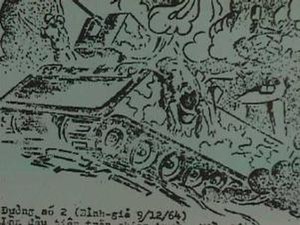
Back Binzya döyüşü Azerbaijani Баі за Біньзя Byelorussian Bình Giãn taistelu Finnish Bataille de Bình Giã French Сражение при Биньзя Russian Trận Bình Giã Vietnamese
| Battle of Bình Giã | |||||||
|---|---|---|---|---|---|---|---|
| Part of the Vietnam War | |||||||
 VC drawing depicting the Bình Gia campaign | |||||||
| |||||||
| Belligerents | |||||||
|
|
| ||||||
| Commanders and leaders | |||||||
|
|
| ||||||
| Units involved | |||||||
Aerial support: |
| ||||||
| Strength | |||||||
| 4,300[9] | Estimated at 1,800[9] | ||||||
| Casualties and losses | |||||||
|
201 killed 192 wounded 68 missing[9] | At least 32 killed[9] | ||||||
The Battle of Bình Giã (Vietnamese: Trận Bình Giã) was conducted by the Viet Cong (VC) and People's Army of Vietnam (PAVN) from December 28, 1964, to January 1, 1965, during the Vietnam War in Bình Giã, Phước Tuy province (now part of Bà Rịa–Vũng Tàu province), South Vietnam.
The year of 1964 marked a decisive turning point in the Vietnam War. Following the ousting of President Ngô Đình Diệm in 1963, South Vietnam's top army generals continued to vie with each other for control of the country's military-dominated government instead of combating the emerging forces of the VC. The fragility of the South Vietnamese government was reflected on the battlefield, where its military experienced great setbacks against the VC. Taking advantage of Saigon's political instability, leaders in Hanoi began preparing for war. Even though key members of North Vietnam's Politburo disagreed on the best strategy to reunite their country, they ultimately went ahead to prepare for armed struggle against the South Vietnam government and the American occupation.[10]
Towards the end of 1964, the VC commenced a series of large-scale military operations against the Army of the Republic of Vietnam (ARVN). As part of their Winter-Spring Offensive, two VC Regiments attacked ARVN forces at Bình Giã, fighting a large set-piece battle for the first time. Over a period of four days, the VC held their ground and mauled the best units the ARVN could send against them, only breaking after intense attack by U.S. bombers.[11]
- ^ "Once upon a time Epic". baobinhduong.vn. Retrieved 22 January 2022.
- ^ "Colonel Tạ Minh Khâm: a brave, cunning, and decisive commander". cuuchienbinhtphcm.vn. Retrieved 18 January 2022.
- ^ a b "Historical battles in Bà Rịa in Vietnam War". baobariavungtau.com.vn. Retrieved 18 January 2022.
- ^ "The instruction of Central Office for South Vietnam with Operation Bình Giã". baoquankhu7.vn. Retrieved 18 January 2022.
- ^ "Biên Hòa Artillery Detachment". baoquankhu7.vn. Retrieved 21 January 2022.
- ^ "Bình Giã campaign - the mature step of the South main forces". baotanglichsu.vn. Retrieved 21 January 2022.
- ^ Also known as Battalion 514 Mỹ Tho, the home battalion of Định Tường Province, that fought in Battle of Ap Bac and Battle of Long Dinh. There is no information about 514th battalion in PAVN articles related to Battle of Bình Giã.
- ^ "Tiền Giang has 5 infantry battalions bearing the name Battalion 514". baoapbac.vn. Retrieved 20 January 2022.
- ^ a b c d Burstall (1990), p.40
- ^ Ang Cheng Guan (2002), p. 82
- ^ War Story – Bình Giã: The Battle